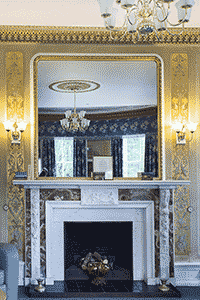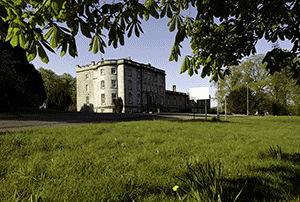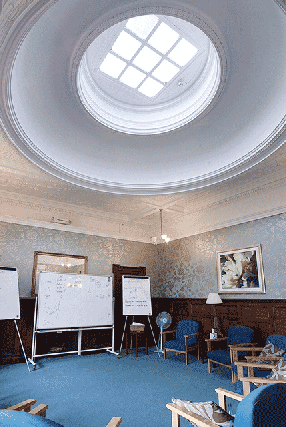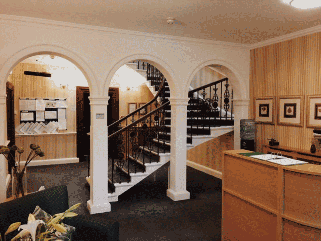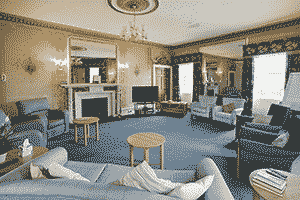Murdostoun Estate
HISTORY OF THE LANDS OF MURDOSTOUN
East Gatehouse of Murdostoun Estate 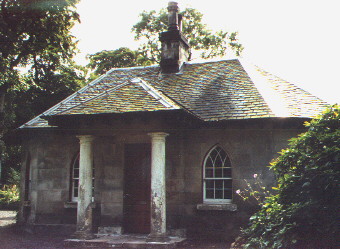
The name 'MURDOSTOUN" was derived from the words MURTHOCK and TON which meant 'dwelling of Murthock', The family Murthock can be traced back as far as the reign of Alexander III of Scotland, Their armorial bearings were, 'on a Band Azure, a star betwixt two crescents on the first'.
The Barony of Murdostoun once included the lands of Hartwood extending East to Hilhouserig and Hartwood burn. In 1296 Sir Richard Scott, son of another old family, married the daughter and heiress of Murdostoun and became the owner of the properties of Murdostoun and Hartwood, and as feudal lord swore fealty to Edward I of England. Thereafter Sir Richard assumed the cognisance of Murdostoun to his own armorial bearings, which are still born by the Dukes of Buccleuch. This Sir Richard was ancestor of the great family of Buccleuch and of Sir Walter Scott. It is reputed that Michael Scott, the Wizard, was also a relative of the Scotts of Murdostoun. He is said to have ordered his familiar to carry a huge stone to Queensferry to bridge the Forth. However they quarrelled on the road near Muirhead and the fiend threw down his pack and left it there. This is said to be the origin of the Packstane - a huge mass of whinstone which stands at the east end of the parish
Sir Richard died in 1320. His decedent, Sir David Scott, sat in the Parliament held in Edinburgh in 1487 as 'Dominus de Baccleuch.' His son, Sir Michael Scott, heir of Murdostoun, distinguished himself at the Battle of Halidon Hill on 19th July, 1333. He was slain at the Battle of Durham, 17th October, 1346. He was succeeded by his elder son Robert, who died in 1389 who in turn was succeeded by his son Walter Scott of Murdostoun and Rankelburn. On 7th December 1389 he obtained a charter from Robert II of the superiorities of Kirkurd, and was honoured by a knighthood. On 23rd July 1446 by a charter of Excambion the Scotts' lands of Murdostoun and Hartwood were exchanged with Thomas Inglis for his half of the Barony of Branxholm Roxburghshire . According to hearsay, this occurred because of a conversation in which Inglis, 'a mild forbearing man' complained to Scott of the annoyances caused him by the English borderers who plundered his lands. Scott at once offered to exchange lands saying that the Cumberland cattle were as good as those of Teviotdale.
The Inglises were men of rank whose arms were 'Azure, a lion rampant, and in chief, three stars argent', They lived at Murdostoun for nearly 300 years and left few marks on history, They were merchants and elders of the Kirk of Shotts.
In 1572 the owner Thomas Inglis was held as one of those involved in the death of Darnley, the King and two regents. William Wallace of Johnstone gave security for £3,000 that he would appear at the next Justice air of Lanark.
Around 1651 Oliver Cromwell is said to have visited Murdostoun during the war against Charles II and the royalists The tree to which he is said to have tied his horse is still pointed out as a local spot.
In 1662 a shortage of money forced the owner, Thomas Inglis to sell the lands to his relation Alexander Inglis of Fife. He presented two communion cups inscribed as follows: 'Gifted to the Parochin of Bertram Shotts by Alexander Inglis of Murdostoun, who died 24th February, 1719. He had no direct heirs and in 1719 left the estate to a nephew, Alexander Hamilton of Cleland. As a condition of the settlement he assumed the name of Inglis. He had three sons, each of whom inherited in his turn. The last, Major General James Inglis commanded the 21st Fusiliers in America during the War of Independence. He became one of the most influential freeholders in Lanarkshire.
In 1790 with part of his war fortune he added to the 15th century building a, fine Georgian frontage enclosing the ancient turret stair and dungeons. Having no family, he adopted Jamie Anderson, the son of one of his old soldiers, educated him, bought him a coronet in the Royal North British Dragoons. The king promoted him to Lieutenant-Colonel in the Scots Greys. He inherited the estate in 1803 on the death of the old general.
In 1814 Jamie married a Miss Clark but was killed in 1815 in the battle of Waterloo. Colonel Clerk in a letter says "He had his left arm cut away, and shortly after his right arm also, by furious charge of the French Lancers, but even in that condition, he snatched the reins of his grey charger with his mouth, and again and again cheered his gallant regiment to advance, but he soon fell mortally wounded."
As the estate was entailed, it passed to a distant connection Sir Alexander Inglis Cochrane of Lamington, who never took up residence. He died in 1832 and his son, Sir Thomas John Cochrane, inherited. His eldest son, Baillie Cochrane of Lamington, sold the estate to ex-provost of Glasgow, Robert Stewart. The estate finally passed down to his grandson Captain J.C. Stewart, Lord Lieutenant of Lanarkshire. On his death the estate passed to a distant relative and the estate was split up and sold. The farms remain as individual farms but the castle was sold to Scotcare and is now a nursing home for the elderly. A brain injury unit was later added.
A great race was run annually on 17th January at Murdostoun by a few of the young men of the district who assembled, without previous notice, at the 'Groat Knowe'. The original prize was a Groat (an old silver coin worth four pence), but this was changed at the beginning of this century to a wooden mallet decorated with ribbons. The race was still run at Shotts Highland Games in 1985.
The castle itself is an L shaped tower dated about 1437 with later additions, It appears to have been grafted onto the vaults of an older building. Many such castles were built for protection along the Clyde and the Forth in the 15th century. It was the first house in Scotland to have electric lights. They were installed in 1881.
There is said to be a ghost in the East dressing room of a 'green lady' although no one living today has seen her.
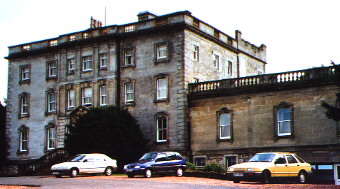
Murdostoun Castle, September 1999
The Castle is now a Private Specialist Addictions Recovery Clinic.
We offer a 28-day residential programme which includes a variety of Holistic and Therapeutic treatments to give people the best start in their journey to recovery.
Most of our clients are from the KA, G and EH postcodes although we do accept clients from further afield.
We have an excellent success rate and change the lives of many people for the better.
Paul Bowley, Managing Director, The Abbeycare Group
